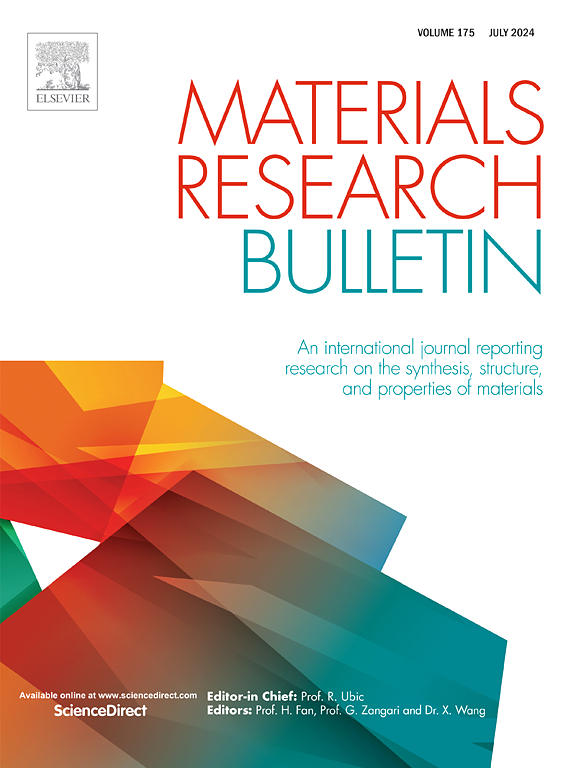Ratiometric optical temperature sensing properties based on up-conversion luminescence of novel NaLaTi2O6:Yb3+,Er3+/Ho3+ phosphors
IF 5.3
3区 材料科学
Q2 MATERIALS SCIENCE, MULTIDISCIPLINARY
引用次数: 0
Abstract
To satisfy the increasing necessity of contactless optical thermometry, utilizing both thermally coupled (TCLs) or non-thermally-coupled (NTCLs) energy levels of rare earth ions in novel phosphors has significant potential for devising the optical thermometers with high temperature sensitivity. Herein, a sequence of novel Yb3+,Er3+/Ho3+ doped NaLaTi2O6 (NLTO) phosphors were sintered using a high-temperature solid-state reaction approach. Structure, phase component and luminescence performance were identified in detail. Upon 980 nm near-infrared (NIR) excitation, the obtained materials presented typical Er3+/Ho3+ characteristic emission wavelengths in visible region, which include two green emission bands around 522 and 543 nm, as well as a weaker red band around 661 nm for Er3+ doped NLTO, a green emission band around 545 nm and a red band around 657 nm for Ho3+ doped NLTO. Besides, a unusual emission band around 757 nm of Ho3+ in visible edge region was also clearly found. The temperature sensing properties of representative NLTO:Yb3+,Er3+/Ho3+ samples were assessed based on the fluorescence intensity ratio (FIR) technique of TCLs or NTCLs energy levels. The maximal absolute sensitivity (Sa) and relative sensitivity (Sr) were determined to be 0.0374 K-1 (293 K) and 0.970% K-1 (293 K) by taking the FIR of NTCLs 2H11/2→4I15/2 and 4F9/2→4I15/2 transitions in NLTO:Yb3+,Er3+. Simultaneously, the maximal Sa and Sr were 0.0306 K-1 (573 K) and 0.776% K-1 (373 K) using the FIR of NTCLs 5F5→5I8 and 5F4,5S2→5I7 transitions in NLTO:Yb3+,Ho3+. Consequently, the temperature sensitivities above can be compared to reported results, which indicate that as-prepared materials have a promising application in optical temperature sensors field.
基于新型 NaLaTi2O6:Yb3+,Er3+/Ho3+ 荧光的上转换发光的比率光学温度传感特性
为了满足日益增长的非接触式光学测温的需要,利用新型荧光粉中稀土离子的热耦合(TCLs)或非热耦合(NTCLs)能级设计具有高温度灵敏度的光学温度计具有巨大的潜力。本文采用高温固态反应方法烧结了一系列新型掺杂 Yb3+、Er3+/Ho3+ 的 NaLaTi2O6(NLTO)荧光粉。对其结构、相组成和发光性能进行了详细鉴定。在 980 纳米近红外(NIR)激发下,所获得的材料在可见光区域呈现出典型的 Er3+/Ho3+ 特征发射波长,其中包括掺杂 Er3+ 的 NLTO 在 522 纳米和 543 纳米附近的两条绿色发射带,以及 661 纳米附近较弱的红色发射带;掺杂 Ho3+ 的 NLTO 在 545 纳米附近的一条绿色发射带和 657 纳米附近的一条红色发射带。此外,还清楚地发现在可见光边缘区域,Ho3+ 在 757 nm 附近有一个不寻常的发射带。根据 TCLs 或 NTCLs 能级的荧光强度比(FIR)技术,对具有代表性的 NLTO:Yb3+,Er3+/Ho3+ 样品的温度传感特性进行了评估。通过计算 NLTO:Yb3+,Er3+ 中 NTCLs 2H11/2→4I15/2 和 4F9/2→4I15/2 转换的荧光强度比,确定最大绝对灵敏度 (Sa) 和相对灵敏度 (Sr) 分别为 0.0374 K-1 (293 K) 和 0.970% K-1 (293 K)。同时,利用 NLTO:Yb3+,Ho3+ 中 NTCLs 5F5→5I8 和 5F4,5S2→5I7 转变的 FIR,最大 Sa 和 Sr 分别为 0.0306 K-1 (573 K) 和 0.776% K-1 (373 K)。因此,上述温度灵敏度可与已报道的结果进行比较,这表明制备的材料在光学温度传感器领域具有广阔的应用前景。
本文章由计算机程序翻译,如有差异,请以英文原文为准。
求助全文
约1分钟内获得全文
求助全文
来源期刊

Materials Research Bulletin
工程技术-材料科学:综合
CiteScore
9.80
自引率
5.60%
发文量
372
审稿时长
42 days
期刊介绍:
Materials Research Bulletin is an international journal reporting high-impact research on processing-structure-property relationships in functional materials and nanomaterials with interesting electronic, magnetic, optical, thermal, mechanical or catalytic properties. Papers purely on thermodynamics or theoretical calculations (e.g., density functional theory) do not fall within the scope of the journal unless they also demonstrate a clear link to physical properties. Topics covered include functional materials (e.g., dielectrics, pyroelectrics, piezoelectrics, ferroelectrics, relaxors, thermoelectrics, etc.); electrochemistry and solid-state ionics (e.g., photovoltaics, batteries, sensors, and fuel cells); nanomaterials, graphene, and nanocomposites; luminescence and photocatalysis; crystal-structure and defect-structure analysis; novel electronics; non-crystalline solids; flexible electronics; protein-material interactions; and polymeric ion-exchange membranes.
 求助内容:
求助内容: 应助结果提醒方式:
应助结果提醒方式:


